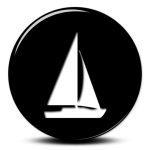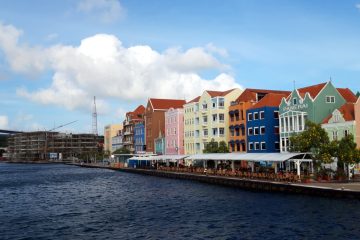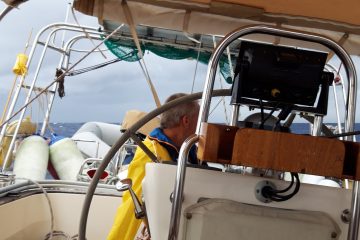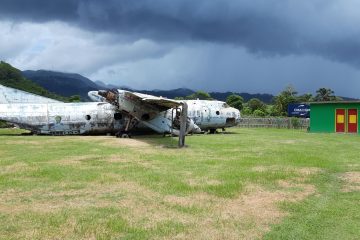After a long trip back from Grenada, via Barbados and Amsterdam, we are finally back in Hamburg.
When we arrived in the airport we were faced with piles and piles of luggage in the baggage reclaim area – literally piles of bags. Amongst them were a few poor souls peering at the hundreds of labels seeking their own bags. Thankfully, we only had hand luggage so were not worried about the recent problems with the airlines and lost baggage.
The main reason for returning is to see family (including a step-sister we didn’t know about!), buy spares and other parts for the boat, and to allow Angelika to work if she could.
There was also the need for medical checks and similar things that are difficult to achieve when out of your home country. Basically there are lots of things that are much easier to accomplish when at “home” in Germany.
“Maya” was left in the capable hands of our Italian friends on “Ciganka”. The deal was that they would look after the boat if they could go on from time to time and run the air-conditioning. This also helps to reduce the humidity levels in the boat so it was a useful thing to be able to do.
Back home it took more than a few days to “settle in” to living in a house and a town again. Everything is so busy and fast.
We planned to visit Angelika’s father as it was his birthday and try to catch up with Angelika’s sister and brother-in-law who are back in Germany and looking for somewhere to live.
We were fortunate with the weather as it was the start of the “heatwave” in Europe (and other places). We were also luckily enough to be able to take advantage of the infamous “9 Euro Ticket”. The ticket was established by the German government to help offset the rising costs of pretty much everything. It costs just 9 Euro (as the name suggests), is valid for a month and allows unlimited travel on all German trains, U-Bahn, S-Bahn, buses and ferries. It is not valid on Express trains, but everything else was covered.
The tickets were planned to be available for June, July and August – perfect for us!
The trip to Heiligenhafen to visit the parents went quite well although the train journeys were a little frantic as everyone took advantage of the good weather and the ticket.
In Travemunde there was a display of “Sand Sculptures” which was a “must see”. We managed to combine this with meeting a couple of friends from Hamburg.
The sculptures were quite fascinating; the amount of time involved to get them right must have been enormous.
At the beginning of July we planned to go sailing with a couple of friends on their yacht “Happy Our 2”. They would meet us in Flensburg and we would sail with them to the Danish “South Sea” islands and finally be dropped off back in Heiligenhafen.
The weather forecast was OK but a little colder than we were used to. We sailed out of Flensburg following the buoyed channel under sail, something I have never done. It was fun! The further we went the better the weather became until we were sailing in bright sunshine but with a cold wind.
Our first port was the Danish island of Ærø. It was quite windy and finally getting the boat alongside in the harbour of Søby taxed the skills of the Skipper (thankfully not me this time). It was not without excitement but eventually everything worked out just fine.
That evening it became clear that I had contracted some bug or other (yes – we checked for Corona – Negative). This meant that I couldn’t eat and had very little energy to do anything other than sleep.
As it turned out we couldn’t actually go anywhere as very strong winds (and rain) had set in making it advisable to stay in the harbour.
The following morning the rest of the crew explored the island with E-bikes whilst I rested and the skipper fussed around doing skippery-things.
After a day or so I recovered enough for all of us to explore the island with the free bus, and then the next day with bicycles. I was well enough to cycle and we had a great ride to the lighthouse “Skjoldnaes Fyr” on the north west end of the island. We also explored some of the countryside and beaches of the island. I have never been to this area and thoroughly enjoyed it.
We also visited to the town of Marstal at the south end of the island. Eventually my brain reminded me that this was the setting for the novel “We the Drowned” by Carsten Jensen. The story follows four generations of sea-farers from Marstal and their combined experiences of two World Wars and the aftermath of them. It’s an interesting read, but suffers from an awkward translation (I believe) – still worthy of a look though.
The Islanders make their own beer on the island and I’m pleased to report it is not at all like the well known products of both Carlsberg and Tuborg. It is known simply as “Ærø” and comes in a variety of tasty flavours.
We sampled a couple of bottles and were instantly hooked on the beer. The good news is that it is widely available throughout the islands; however it does not seem to be available in Germany.
After a few more days stuck in Ærø the weather finally improved enough for us to leave and head for the next island – Langeland. This was just a short hop across the sea and therefore relatively simple to do.
With the wind behind us we set off along the well buoyed channel. We managed to sail past Ærøskøbing but soon afterwards the channel makes a sharp dogleg turn and becomes much narrower and shallower. The [sensible] decision was taken to drop the sails and continue under engine as there was a lot of traffic in the channel. It was left to me to steer the boat along the channel which is marked by red and green poles topped with what appeared to be either a red toilet brush or a green plastic Christmas tree.
In front of us was a slow moving wooden boat that seemed intent on getting in the way. It became apparent that he was slowing down and preparing to enter the harbour at Marstal. Coming up fast from behind was a car ferry which took up much of the channel, further limiting the space available.
Near the entrance to the harbour I could no longer see the marker poles/buoys and was unsure as to where I should be going. Coming towards us were several yachts which were clearly going to be too close for comfort – I couldn’t understand why they would be so close to us. We were getting closer to the harbour wall with no way out – I was anxious and totally confused.
Then Angelika told me that we had to enter the harbour as the channel went through it and out the other side. This was marked by a large, white arrow on the harbour wall, which in turn was completely obscured from me by the slow wooden boat. Once I knew this I understood why the oncoming boats were so close – I was completely on the wrong side of the channel!
I would like to thank the crew, who all knew about the arrow and harbour entrance, but hadn’t bothered to tell the helmsman (me!).
After this little incident the rest of the way to Langeland was uneventful. We even managed to sail again.
On entering the harbour of Bagenkop (on Langeland) I handed the helm back to the skipper as I did not want to attempt entering the berth (or “box”) for the first time.
The berthing arrangements in this part of the world are somewhat simple, but in a complicated way. Each berth consists of two poles located just over a boat length away from the jetty – you have to pick a berth that you think you will fit into both width-ways and length-ways. Then, having picked your berth and rigged two lines at the bows and two at the stern, you drive confidently between the poles and the poor crew have to effectively lasso the pole on both sides then run to the bows to jump ashore before the skipper rams the jetty. At the same time the skipper has to deal with the wind/current/other boats.
It’s all quite simple with four crew, no wind and no current PLUS helpful boaters on the quay waiting to stop the boat and take the lines. But with two people, a strong wind or current or no helpful people it looks to be a nightmare. Med-mooring with a bow anchor and reverse to the quay/jetty suddenly seems a very simple manoeuvre!!
Anyway, the skipper performed the manoeuvre well and the crew managed to skillfully lasso the poles. Another crew performed acrobatics at the bows to get the bow secured properly.
Whilst we were doing this the harbour rapidly filled up and soon there were no places left. A couple more boats arrived but had to tie alongside in the harbour entrance. By now the wind had picked up and was driving quite a heavy chop into the entrance. The boats tied up there were bouncing up and down and looked very uncomfortable
Then a small Polish boat arrived with a family and three younger children on board. They searched in vain for a space inside, but it was full, so they opted to tie outside the harbour against a line of lorry tyres. We could see the little boat was jumping up and down in an alarming fashion and took pity on the poor crew.
Next to our berth was a long wall marked with yellow paint – it’s supposedly for when the fishing fleet come to unload or something like that. The fishing fleet was clearly already in the harbour and had no intention of leaving, so this space was clear.
We walked around the harbour to the Polish boat which looked terribly uncomfortable. It was jumping up and down in the swell and really tugging on the mooring lines. We found one of the crew and told them that they ought to try the yellow wall near us. The skipper knew of the wall, but thought it was for a ferry – it’s not.
They very quickly agreed it would be a good idea to move their yacht inside and tie to the wall – if someone did come and complain they would just have to leave again.
Within 20 minutes their boat was snugly tied against the yellow wall and laid perfectly still. You could feel the relief of the family and children to be somewhere calm and safe.
The next morning they were still there – no-one had complained, no fishing boats had come and no ferry either.
The next morning we left relatively early for the final leg to Heiligenhafen. Leaving the berth was simply the reverse of entering and once again we were blessed with calm conditions. With a strong wind I can see that manoeuvre also going badly wrong.
It was another sunny day, but with very little wind. We ended up motoring pretty much the entire way. The most interesting part was crossing a very busy shipping lane between Denmark/Sweden to the North Sea. Many ships were heading along this route and we had to cross from one side to the other.
Now I have had quite a bit of experience with shipping lanes in the English Channel, the Straits of both Messina & Gibraltar and off the coast of Morocco. The rule is that you keep out of the way of the big ships as they won’t change course or slow down for you.
To my amazement the ships in this busy shipping lane happily slowed down or changed course or both to avoid not just us, but many other yachts crossing the lane. I stared open mouthed at the ships both around us on the sea and displayed on the chart plotter – it was clear they were the ones avoiding us, not the other way round.
The final run into Heiligenhafen was uneventful and we found a good berth. We repeated the crazy dance with the boat/poles/ropes and were quickly tied up nicely in the berth.
Both Angelika and I had sunburnt lips and hands after this trip – this has never been a problem even after years of living in hot countries. It would seem that the sun in the Danish South Sea is really fierce!
After a nice evening dinner with the crew we left the boat and they were free to continue their holiday in the Danish South Sea!



